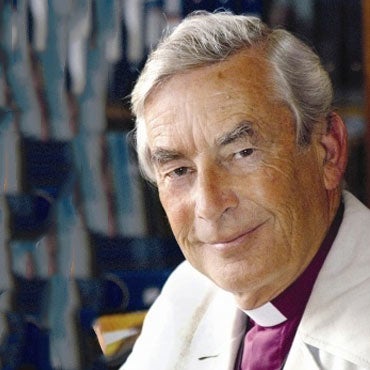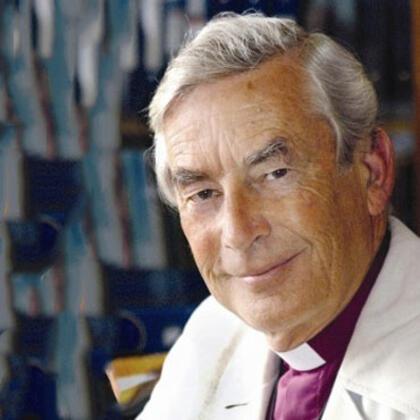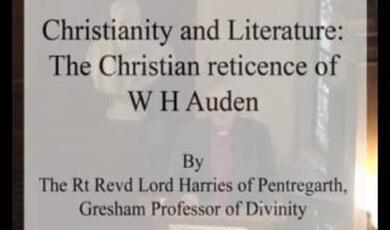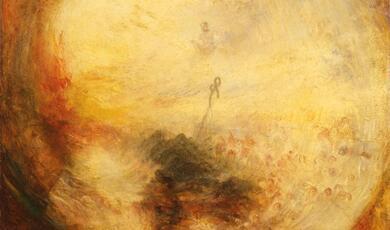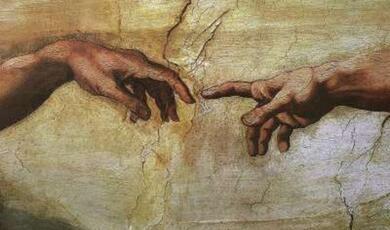Christianity and Literature: Are happy endings real?
Share
- Details
- Transcript
- Audio
- Downloads
- Extra Reading
The enormous suffering experienced during the 20th century, combined with the insights of that master of suspicion, Sigmund Freud, has made us deeply sceptical about the possibility of happy endings, popular though they are amongst readers. This is an issue for novelists and presses in a particular way upon those who wish to tell the Christian story of resurrection and ultimate redemption.
Download Transcript
CHRISTIANITY AND LITERATURE: ARE HAPPY ENDINGS REAL?
The Rt Revd Lord Harries of Pentregarth
To celebrate World Book Day on 2nd March 2006 a poll was commissioned amongst readers of various kinds about the kind of ending they preferred. Forty one percent wanted a happy ending. Only 2.2% chose a sad one. The author Adele Parkes made her own position quite clear. "I think my readers deserve happy endings: there's enough grimness to deal with without adding to it". William Boyd took a totally contrary point of view, arguing that serious literature has to reflect the grimness of life. Happy endings lead us into the realm of "fantasy, romance and fairy tale," as he put it, which he disliked.
One of the interesting questions for me is whether the Christian faith offers a happy ending or not. Clearly many people think it does and this is one of the reasons they dismiss it as so much "fantasy, romance and fairy tale," to use William Boyd's terms. Whether it does or does not offer a happy ending is one of the underlying questions of this lecture, to which I will return. Closely related to this is whether it is possible to have happy endings, in novels or in religion, which have integrity; that is, endings that take the tragic dimension of life with all seriousness, that don't pretend that suffering is other than it is, and which offer a conclusion that comes across as real as the tragedy. I'm interested in this question both in relation to novels and from the standpoint of religious faith, because the problem is essentially the same; how to convey a deep continuity, a hardcore of integrity running right through both the suffering depicted and its resolution, without being open to rejection of the latter on the grounds of fantasy, romance and fairy tale.
Let me begin with a contrast of two novels. I will take Jane Austen'sPersuasion and Philip Roth's The Human Stain,though there are many more one could have taken to make the point. The central character ofPersuasion is Anne Elliot, the denigrated daughter of two very snobbish parents. Her father, Sir Walter, who is in fact in debt, judges everyone strictly by their lineage. Anne is highly uncomfortable about this and embarrassed. She falls in love, but on the advice of a friend decides, with much pain and grief, to reject the man for his lack of wealth and family background. For seven years she goes downhill in terms of health and looks but then suddenly Wentworth, the rejected suitor, comes into the picture again. The old love between them is still there but neither knows it. However, after much longing and misreading of body language all is revealed and they marry. In a world of great snobbery, pretence and manipulation Anne values people for themselves and offers sincerity, constancy and true friendship. In the novel, very happily, these win through in the end, and she is rewarded with marriage to the man who loves her as much as she loves him.
It should not be thought that this is a heavily didactic novel. It isn't. Indeed Jane Austen consciously distanced herself from Hannah More, who did write novels to inculcate certain values. The characters have all Jane Austen's characteristic life and vitality. They have a vivid life of their own. But it does illustrate two related points I made in my first lecture: all worthwhile literature reflects a set of values, but we can still tell the difference between literature and propaganda. The feature I want to draw out here, however, is that Anne exhibits a strong set of values, and for her there is a happy ending.
The other novel, written recently, nearly 200 years after Jane Austen, Philip Roth's The Human Stain also reflects a strong set of values, but it is a tragic story. The central character Coleman Silk has been a highly successful Dean in a University, but an innocent remark of his was interpreted as racist and he was hounded out of his teaching post by a highly ambitious Frenchwoman whom he had appointed. What only gradually emerges in the story is that Coleman had himself been born into a black family, but because his skin was quite fair, he had deliberately recreated himself as a white person and sundered all ties with his past, including his parents. After his humiliation in the university he finds himself in a powerful sexual relationship with Faunia Farley, who all her life had been a victim, first of child abuse and then of a violent husband. This ex- husband, thrown off balance by his service in Vietnam, kills Coleman and Faunia. The story is a modern tragedy, as indicated by an opening quotation from Oedipus. Coleman, who has by talent and a superb effort of the will created himself as a successful white man is tripped up by wider forces at work in society. So incidentally, in a different way, is the ambitious young French woman. The Human Stain is a good title. But it could equally have been "Human sin"-for we are conscious of the racism of American Society, the brutality of the Vietnam war and pretentious scholarship, forces which makes victims of some and stains everyone involved in one way or another.
You could have fun trying to re-write the Roth novel with a Jane Austen type ending, and vice versa, the Austen one with a Roth type tragic dimension to it. But I won't try.
There are a number of reasons why we are deeply suspicious of happy endings, much though we may enjoy them on occasions. First, life - at least for a great many people, is indeed grim. This sense of the grimness of life was sharply accentuated during the cruel 20th century with its two World Wars, Stalin's purges and numerous atrocities such as that of the Pol Pot regime in Cambodia. Above all of course, there was the holocaust, after which it was said that there could not be poetry or literature any more. The fundamental shift in consciousness brought about by the 20th century, perhaps in the worst in human history, is vividly illustrated by the reception history of Grunewald's masterpiece of Christ crucified on the Isenheim altar. This is a painting of the crucifixion which more than any other shows Christ in agony. It was a painting, hardly discussed in the 19th century that was shown in Munich for a year during 1918-19. It suddenly promulgated and reinforced a German self-image as a martyred angst-ridden people and then later in the century came to express the self-image of an anguished European people as a whole.
Secondly, at the same time Freud was imbuing Western culture with the notion of wishful thinking, brilliantly summed up the lapidary praise of Iris Murdoch "All that consoles is fake". It is not surprising therefore that the dominant Christian image in painting in the 20th century is Christ crucified and attempts to convey the resurrection of Christ or anything hopeful are very few. In his draft notes on religion and theology, W H Auden wrote "Today, we find Good Friday easy to accept: what scandalises us is Easter: modern man finds a happy ending, a final victory of love over the Prince of this World, very hard to swallow".[1]
But does Christianity offer a happy ending? The traditional view does of course affirm the reality of the resurrection as a pledge of the final victory of God's love over all this is evil, including death. But on that ancient view heaven was reserved for true believers, the fate of millions of others was more sombre. Not a happy ending for them. In fact Christianity has never offered a happy ending in any straightforward sense - rather it has emphasised the inescapable tragic dimension to life. Sin has seeped into every aspect of human existence. Christ was rejected and crucified and God remains implacably opposed to our wickedness and smugness. Yet, even without a traditional view of the resurrection or a belief in the afterlife people have been able to see something victorious in the life of Jesus. As mentioned briefly in my first lecture, when we watch a great tragedy by Shakespeare or one of the ancient Greeks, we often experience something strange and paradoxical. We watch terrible things happen, yet come from the theatre more conscious than before of the preciousness of life and the worthwhileness of the human endeavour. It's as though the very destruction and death highlight the value of what is destroyed and the supreme importance of living bravely and well. It's that paradoxical experience of tragedy that gives us an insight into the meaning of things, even when they are grim. On this view the resurrection of Jesus is a shift in consciousness in the minds of his followers. From defeated abject disciples contemplating the total failure of his mission, they come to see that mission, and in particular his life of total commitment to the concept of a divine kingdom of love, as something worth committing their lives to; as something victorious however the world goes. This is a view of the resurrection held by some theologians and why the original ending of Mark's gospel, with no resurrection appearances, simply the women finding the tomb empty with the words "And they said nothing to anyone for they were afraid" has had a profound moral and spiritual appeal to some people. I'm not for the moment arguing the truth of this view of the resurrection; indeed I will later suggest that it's not an adequate account. I mention it here now simply in order to highlight the point that Christianity does not necessarily offer a happy ending in any conventional sense and it can be understood in a way which is congruous with the deeper insights of morally serious people.
Beginning with that perspective, however, what roughly speaking we might term a grim or tragic view of human existence I would like to test out the thesis of Nicholas Boyle that I mentioned in my first lecture, that the very act of representation is an act of affirmation of what is represented and, from a Christian point of view, a powerful witness to the worthwhileness of creation in general and human life in particular. I will test this briefly in relation to three recent novels. First J M Coetzee'sDisgrace[2]. In this exceedingly bleak novel the main characters end up scarcely distinguishable from the dead dogs which they spend their time burying. It's a novel that I have found more difficult than any other in recent years in which to see any spark of hope or humanity. Perhaps I've read it wrong, but if I haven't its difficult to see how it can support Boyle's thesis that representation alone affirms the value of what is represented. In this novel there is such a bleak view of human life, just animal flesh to be buried, that representation of it reveals its worthlessness not its worth-whileness. Then there is Philip Roth's A Dying Animal[3] (a quotation from W B Yeats) whose title suggests something hardly more positive, yet which turns out to suggest something rather different. A man in his 60s lives only for his sexual desires. He enjoys the fruits of the 1960s, for girls throw themselves at him. Then an old girlfriend comes to see him to ask him once more to admire her fine breasts. She has cancer and is about to have a mastectomy. She wants him to visit her in hospital. Yet a friend warns him against it. "Think about it. Think. Because if you go, you're finished". This is because as Conrad, who is quoted, said "Attachment is ruinous and your enemy". Again "He who forms a tie is lost". He is old, he lives an animal existence. She is dying. But he finds himself attached with a tie born through sex but which goes beyond sex. Here, we might say, are dying animals, but nevertheless they form attachments and in that is both our tragedy and our glory as human beings. This is a novel that in no way takes away from the sheer physicality of human existence but it also reveals that we are more than flesh and blood. Using Boyle's perspective, it's not a view of human life that you need to be a Christian to see, but it is one which, so a Christian will argue, finds its foundation and proper fulfillment within a Christian view of existence. Making attachments is fundamental to what it is to be a human being, a creature stamped with the divine imprint.
The third novel I want to refer to is The Story of Lucy Gault[4] by William Trevor. The Gault's are an old Protestant family living in Cork. In the 1920s such families are leaving the south. Three boys come to the house with a can of petrol and Lucy's father shoots one of them in the shoulder. He did not intend to hit him but despite apologies to the family of the shot boy, the Gault's know that they too will have to leave. Lucy, who loves the rural life, is reluctant and at the time of the family's departure runs to a hovel hidden in the woods. However, her habit had been to bathe on the local beach with her dog and recently the dog had playfully taken one of her vests and one of her shoes and buried them in the sand. When the search for Lucy was started, these were found and everyone assumed she had drowned. The parents left Ireland determined never to return. Lucy nearly starved to death but was eventually found. Despite efforts to trace them her parents could not be found. They moved from lodging to lodging on the continent. Although Captain Gault her father wrote letters back to Cork, he could never bring himself to post them for fear of upsetting his wife, whom he loved dearly. So Lucy was bought up by servants waiting for her parents to return. Once she met a young man and they fell in love but despite his pleas she wouldn't marry him. She would continue to wait for her parents. Even after World War II she refused and so he married someone else.
Eventually Mrs Gault dies and the Captain returns: making a relationship with his now middle-aged daughter was not easy but they eventually find a way of living together. Then he too dies. Meanwhile, the boy who had originally intended to burn the house down, an act which triggered the whole tragic story, goes insane and is incarcerated in a local mental hospital. For 17 years Lucy faithfully visits him and is the only mourner at his funeral.
Lucy herself gets very old and is visited by nuns. They were amazed that despite the fact that calamity had shaped her whole life story, she was tranquil and nearly at the end Lucy reflects on her years alone, her years of visiting the asylum in these words:
What happened simply did. The cow parsley was white every month of May when she drove away from the high spiked gates, the fuchsia bright in autumn at the cottage where the greyhound was always on the wall. Her visits were the joy in that inmate's life, an old keeper said years later, before they pulled the place down. A flicker in the dark, he said, even though the inmate never knew who she was.
She should have died as a child; she knows that but has never said it to the nuns, has never included in the story of herself the days that felt like years when she lay among the fallen stones. It would have lowered their spirits, although it lifts her own because instead of nothing there is what there is.[5]
It is difficult to imagine a more calamitous, tragic, sad story. Yet her spirits are lifted when she reflects that she did not in fact die "Because instead of nothing there is what there is". It is a story which does, I think, triumphantly vindicate Boyle's view that representation affirms what is represented: that creation, despite everything, is good. In Auden's words, we can - must? - "Bless what there is for being".
There is a further point to be made in relation to many modern novels. However much they reveal of human brutality and sadness, there is an affirmation, explicit or implicit, of some values; values which may in fact be starkly outlined just by their apparent denial as part of the plot. InThe Human Stain that I have just discussed for example, it is the racism in society, and the brutality of the Vietnam War, which have stained the individuals. And there is in fact one character who exhibits a genuine integrity-Coleman's sister. She remained in her original environment working as a nurse. She refused to go along with the rest of the family who vowed to have nothing more to do with Coleman, because he had said he would cut himself off from them. She kept in touch with him over the telephone, but never revealed his secret to anyone. At the same time she made it clear that she strongly disapproved of what he had done. She is a woman of strength and integrity, who remains true to her strong values. Though not a central character, she points up the falsity and hubris of the world to which the others are conforming.
In a similar way it is possible to see the life of Jesus as a tragedy, but one which reveals and affirms certain fundamental values. A character in an Iris Murdoch novel is asked his view of Christ and he replies:
I have to think of him in a certain way, not resurrected, as it were mistaken, disappointed-well, who knows what he thought. He has to mean pure affliction, pointless suffering, the deep and awful and irremediable things that happen to people.[6]
That is a powerful but characteristic approach of a modern novelist to Christ. But a novelist might also want to suggest that in the values that Christ taught and represented there shines out something of abiding worth; and that these shine out all the more clearly against the dark background of his rejection and death. Further, we could say that it was this that changed the hearts and minds of his first followers to the extent that they gave up their own lives to follow him. Christ was resurrected in and through them.
I suggested earlier that to understand the resurrection of Christ in this way, in terms of a change in the hearts and minds of the first followers of Jesus has great moral and spiritual appeal. But is it enough? Is it enough to give hope that life is not finally tragic? And if it's not finally tragic, is it possible to talk about resurrection, about redemption, about things coming right, in a way which doesn't immediately come across as a happy ending that is simply tacked on, one which lacks artistic and moral integrity, which lacks the kind of moral and spiritual grittiness we discern in a tragic view of existence?
Shusako Endo, who has been called the Japanese Graham Greene, is best known for his two novels about Christians in Japan in the 16th and early 17th century. Christianity was brought to Japan in the middle of the 16thcentury and by 1614 there were 300,000 in a population of 20 million. But the rulers turned against them and thousands were tortured and crucified to force them to renounce their faith. Silence, the title of Endo's novel which refers to the apparent silence of God at this time, deals with this terrible period of persecution. Samurai is his other novel set in the early 17th century when things were just beginning to look ominous. It follows the fortunes of four Samurai, or minor gentry, who are on a diplomatic mission to Mexico and Europe to explore the possibilities of trade. Travelling with them as an interpreter is a Jesuit priest. As the politics change, the Samurai first embrace the Christian faith then abandon it. Because they had embraced it they went back to Japan knowing that torture and death awaited them. The novel brings out powerfully not only the universal self-seeking and misery of humanity but the difficulty that Japanese culture finds in seeing anything admirable in Christianity, especially the figure of someone crucified.
In Mexico the mission came across a strange man, a Japanese living with the Indians. It turned out he had been bought up in Japan by a Christian priest and himself had become a believer, indeed a monk. But he had become disillusioned with the institutional church both in Japan and Mexico and now lived with the Indians trying to help them. As he says:
Wherever the Indians go, I shall go; where they stay, I shall stay. They need someone like me to wipe off their sweat when they are ill, to hold their hands at the moment of death. The Indians and I-we are both without a home.[7]
When the Samurai go home one of them pulls out a piece of paper given him by that strange Japanese. Written on it were the words:
He is always beside us.
He listens to our agony and grief.
He weeps with us.
And says to us,
"Blessed are they who weep in this life, for in the Kingdom of Heaven they shall smile."
Then he reflects
"He" was that man with the drooping head, that man as scrawny as a pin, that man whose arms stretched lifelessly out, nailed to a cross...for some reason he did not feel the same contempt for him he had felt before. In fact, it seemed as though that wretched man was much like himself as he sat abstractly by the hearth.[8]
Later he speaks to his servant Yoso, a Christian who had followed his master through thick and thin:
"I suppose that somewhere in the hearts of men, there is a yearning for someone who will be with you throughout your life, someone who will never betray you, never leave you-even if that someone is just a sick, mangy dog. That man became just such a miserable dog for the sake of mankind."[9]
Then Samurai leaves his home for virtually certain death
The swirling flakes seemed like the white swans of the marshlands. Birds of passage which came to the marshland from a distant coutry and then departed for a distant country. Birds which had seen many countries, many cities. They were himself. And now, he was setting off for another unknown land...
"From now on".he will be beside you."
Suddenly he heard Yoso's strained voice behind him.
"From now on he will attend you."
As you can see it is a novel that powerfully reinforces the point I made earlier, that in our time it is Christ crucified to whom we respond. In Japan, of course, in addition to the catalogue of horrors that I mentioned earlier there was the bombing of Hiroshima and Nagasaki, the traditional centre of Christianity in Japan. But the novel is not just about universal suffering and the failure of every human endeavour. In all this "From now on-he will be beside you...from now on...he will attend you."
For Endo in that novel, the suffering, crucified Christ lives as a continuing presence with those who suffer. Now I would now like to refer to two other novels from the 1970s, which both deal with the theme of resurrection and redemption but in a rather different way and which seek to do so in a way which is integral to the novel as a whole. First Patrick White's Riders and the Chariot. In an Australian suburb Himmelfarb, a Jewish refugee from Germany, is strung up in a mock crucifixion. After his death strange things happen to the four main characters, the four riders in the mystical chariot. Two ladies talking together after the event were at pains to emphasise that there was no miracle "Only, there was no miracle. Definitely no miracle!" [10]Mrs Colquhoun was almost shouting. But she, and Alf Dubbo, who expressed his faith in fate, Mrs Godbold, a solid washer woman and Miss Hare, all have mystic visions of one kind or another and their lives are changed. In worldly terms all are marginal, all failures, yet in their different ways they've all been given a glimpse into the truth of things through Himmelfarb's death. Through that death they have all, in different ways, been taken up into another dimension.
The other novel is William Golding's Darkness Visible, the least known and least understood of his works. The central character is Matty, who emerges out of a fire in London's Blitz most terribly disfigured. From his earliest days and throughout his life people cannot bear even to look at him. Matty's mind is a strange one, scared as it is by his terrible experience but it keeps formulating a pressing question "Who am I?" The question is never answered but Matty comes to reformulate it as "What am I for?" and begins to feel he exists for something. When he is working as an odd job man in a smart prep school there is terrorist attack as part of an attempt to kidnap some of the boys and he is killed. But he seems to become one of the flames in the fire, fire being a key image in the book. The flames of fire force one of the terrorists who is fleeing with a boy, to let him go. Even more remarkable is what happens next. Whilst a child Matty had met Mr Pedigree, a paedophile, who'd been revolted by Matty but Matty through some strange misreading of the relationship had become devoted to Mr Pedigree. At the time of Matty's death Mr Pedigree is in the grip of one of his compulsive cycles and is waiting outside a public lavatory to seduce some children. Matty appears to him in a vision of gold to free him from his enslavement
He came and stood before Pedigree and looked down at him. Pedigree understood that they were in a park of mutuality and closeness where the sunlight lay right on the skin.
"You know it was all your fault Matty."
Matty seemed to agree; and really the boy was quite pleasant to look at![11]
As in Riders in the Chariot there is a contrast between two worlds. When the terrorists attack the school in order to kidnap the children the media is focused on all the outward events, with TV cameras and reporters rushing everywhere. The death of an obscure, strange odd job man is not noticed. But while the world watches these dramatic outward happenings another plot is all the time being worked out. Matty is an agent of redemption. He knows his life exists for something and his death releases him from the constraints of time and space for the redemption of Mr Pedigree. I'm not for the moment arguing the merits or the demerits of these novels, though both authors won the Nobel Prize for Literature, simply giving them as examples of serious attempts, which in no way shy away from the most appalling features of human existence, to think about resurrection and redemption in a way which has artistic integrity.
In 2006 I delivered the President's lecture at the Hay Literary Festival on the theme of the present lecture, and at the end there was a space for questions. "Why are all the novelists you have chosen male?" for the first one. I felt awful. They had all been male. And my mind went a sudden blank about what women writers I ought to have referred to. One I certainly ought to have mentioned was Flannery O'Conner. Flannery O'Conner was born in 1925 and died at the age of 39 after years of a painful, incapacitating illness. Two facts are fundamental to her writing. She was a practicing Catholic, and she lived in and wrote about the American Protestant bible belt that she knew well, usually poor, whites, uneducated, bizarre and caught up in fundamentalist religion. Flannery O'Conner has written very definite things about the challenge of being a believing Christian novelist in a largely secular Western world. She has said, for example, that one of the reasons she writes about the unfashionable people she does is because their faith and passion reveal truths that are hidden from politer society. More deeply, in a time when Christian truth is ignored or rejected, to believe in the incarnation and redemption makes a total difference to the way one sees things. As she put it, the Christian novelist:
Will have, in these times, the sharpest eyes for the grotesque, for the perverse, and for the unacceptable....[12]
This is certainly born out by the novel of William Golding to which I have just referred. O'Conner has also written:
The Christian novelist is distinguished from his pagan colleagues by recognizing sin as sin. According to this heritage he sees it not as sickness or an accident of environment, but as a responsible choice of offence against God, which involves his eternal future. Either one is serious about salvation or one is not. And it is well to realise that the maximum amount of seriousness admits the maximum amount of comedy. Only if we are secure in our beliefs can we see the comical side of the universe.[13]
She believed that the deep South of America still reflected this sense that our human condition is a broken one: that sin is a reality. And though the South was not Christ centered it was certainly Christ haunted.
No less important to her is the working of grace in her characters. As she put it:
"My subject in fiction is the action of grace in territory held largely by the devil."[14]
So even when the central character of a story is what she terms a freak, she is trying to show what we have in us to become and what we could become. There is in her stories, she says, an action that is totally unexpected yet totally believable. Such an action indicates that grace has been offered. Frequently it is an action in which the devil has been the unwilling instrument of grace.
Flannery O'Conner wrote both novels and short stories. I am going to deal with just one of her short stories, which illustrates her basic philosophy of writing, called Parker's Back[15]. It is only twenty pages but she worked on it over many years and finished it as she was dying in hospital.
Parker left school early, ran away to join the Navy, but one leave failed to return, so after nine months punishment was discharged. He did odd jobs to earn a living and had married Ruth, whom he thought ugly, but whom he somehow wanted to attract.
Parker's obsession in life was tattooing. His whole body, except his back is covered in tattoos. One day after an accident on a tractor he went to a local town and had his whole back tattooed with a Christ Pantocrator in mosaic design-the rather stern figure which is usually found on the ceiling of the dome of an Orthodox church- which he just happened to see in a book of designs and about which he knew nothing. Parker goes home and in expectation that his wife, who is religious will be pleased, shows her his back. She does not recognize the Christ of the Orthodox tradition, beats him over the back with a broom and he goes into the yard to weep.
Parker's obsession with having his body tattooed is bizarre, but it seems to be religiously important to him. When he was fourteen he saw a man tattooed all over in a fairground, and the sight of his body, in its glorious designs and colours was a moment of revelation for him. Then, although his life seemed all futile drift, with nothing achieved, he senses a destiny behind it. This destiny is at once a reality pursuing him, from which he wants to flee, and a glory in him which wants to be revealed. When he first met his wife he sat on her porch looking across the highway to a vista of hills. The story describes Parker's state of mind.
Long views depressed Parker. You look into space like that and you begin to feel as if someone were after you, the Navy or the government or religion.
After he had had his back tattooed he drank a bottle of whiskey with friends then went out side and sat on the ground and examined his soul.
He saw it as a spider web of facts and lies that was not at all important to him but which appeared to be necessary in spite of his opinion. The eyes that were now forever on his back were eyes to be obeyed. He was as certain of it as he had ever been of anything. Throughout his life, grumbling and sometimes cursing, often afraid, once in rapture, Parker had obeyed whatever instinct of this kind had come to him-in rapture when his spirit had lifted at the sight of the tattooed man at the fair, afraid when he had joined the Navy, grumbling when he had married Sarah Ruth.
Although Park appears to dislike his wife he has this strange desire to please her. It was for her sake that he had his back tattooed with a religious picture, because she was religious even though he was not. He thinks that showing his back to her will make it all right between them. But she rejects the picture and him.
Parker was too stunned to resist. He sat there and let her beat him until she had nearly knocked him senseless and large welts had formed on the face of the tattooed Christ. Then he staggered up and made for the door.
His wife looks out and sees him crying like a baby. Suddenly we see the longing and suffering of Parker; and the longing and suffering of Christ in him. Parker, an ordinary, uneducated, unattractive, rather useless man with a futile obsession, caught up in an apparently loveless marriage. Yet a man who, almost totally uncomprehending, knows that God is ceaselessly searching him out and who senses the glory of God to be revealed in him.
We can see how well this story fits in with Flannery O'Conner's philosophy of how a Christian writer has to write in a time of indifference and unbelief-with a narrative that is totally surprising and shocking. In terms of the main theme of this lecture, it is hardly a happy ending in any straightforward sense of the term. But of course it all depends on what the end, in the sense of the telos or goal of human existence is. If it is that the glory of God might be revealed in and through us, then, this is what we see in even such an unlikely person as Parker.
It is I think no accident that the novels I have been referring to in this lecture date from forty years ago or so. It is difficult to think of a novel of comparative quality on the same theme in the last five years. And this is, amongst other reasons, because the situation for the writer of faith is even more difficult now than it was then.
This came home to me very strongly watching Mike Leigh's play 2000 Years. It is a play about a north London Jewish family. The grandparents in their younger days were ardent, atheistic, socialist Zionists and that is still their ideal. Their children are totally assimilated agnostic non-observant north London Jews. Suddenly their son, the grandson of the ardent Zionists, gets religion in a big way. He becomes strictly observant to the shock, horror and chagrin of both his agnostic parents and his atheistic grandparents. The first act is a brilliant disclosure of this situation in all its surprise and humour. The second, final act, goes nowhere. There is no advance in the plot; no deepening of understanding or insight and it peters out inconclusively. The family simply didn't know what to do about their son: nor, one feels, did Mike Leigh - nor does our culture. For what happened in that Jewish family is happening in a parallel way in Christian and Muslim families. The literary world is shocked by the persistence of religion, particularly in its fundamentalist form, doesn't understand it and finds it distinctly unpleasing. Mainstream liberals in the three religions find themselves in an awkward place defending a non-fundamentalist understanding of religion against fundamentalists on the one hand and the concept of religion as a serious intellectual concern against what Schleimacher in the 19th century termed "The cultured despisers" of religion on the other. In this situation it's very difficult to get a serious debate about religion. One that is not marked by mutual ignorance, lack of understanding and disparagement. The difficulty is acute both in life and literature.
I would just like to suggest that novels remain truest to their art form when they avoid what has been termed a premature closure, whether in the course of an optimistic or pessimistic reading of life. Rowan William's recent book on Dostoevsky makes this point well, arguing that Dostoevsky always drives the narrative on trying to keep the debate about God open.[16] If it is the fault of much religion in the past, that it has given a premature closure to an optimistic reading, it is perhaps a fault of some fiction today that gives a premature closure to a pessimistic one. Graham Greene once said something like "My faith is my faith that my unbelief will be proved wrong". In his novel Monsignor Quixote, the central character is a priest who claims to be descended from the famous fictional character Don Quixote. This annoys an American professor who says - I haven't much time for fiction. Facts are what I like." This draws a response from a monk "Fact and fiction-they are not always easy to distinguish". Such is the charm and power of the book you come to share that point of view. Father Quixote is a mixture of innocence, shrewdness and goodwill travelling with his friend the Communist mayor. He has been forbidden to celebrate the Eucharist by his bishop but dying and delirious insists on celebrating Mass without any bread and wine, getting his companion the atheist mayor to kneel. When the priest dies the mayor reflects
Why is it that the hate of a man-even of a man like Franco-dies with his death, and yet love, the love which he had begun to feel for Father Quixote, seemed now to live and grow in spite of the final separation and the final silence-for how long, he wondered with a kind of fear, was it possible for that love of his to continue? And to what end?"
Novels are perhaps most satisfactory when in subtle ways they suggest that there might be more to life than the bleak or tragic course of events they so often realistically and rightly present: when they leave a window open for the possibility of redemption, even eternal life, as in that novel: when, to echo Graham Greene we finish with an enhanced sense of hope that our characteristic pessimism about life might perhaps be shown to be groundless.
©The Rt Revd Lord Harries of Pentregarth, Gresham College, 6 November 2008
[1] Notes on Religion and Theology, 1966-67, Holograph Notebook in the Henry W and Albert A Berg Collection, New York Public Library.
[2] J M Coetzee, Disgrace
[3] Philip Roth, A Dying Animal
[4] William Trevor, The Story of Lucy Gault, p 227
[5] Ibid. p.227
[6] Iris Murdoch, The Good Apprentice, Chatto and Windus, 1985, p.147
[7] Shusako Endo, The Samurai, p. 121
[8] ibid. p. 242
[9] ibid. p. 245
[10]Patrick White, Riders in the Chariot, Penguin 1974, p.484
[11]William Golding, Darkness Visible, Faber, 1979, p.263
[12]Flannery O'Conner, Mystery and Manners: Occasional Prose, Faber 1984, p.33
[13]ibid. p.167
[14]ibid. p.108
[15]Flannery O'Conner, "Parker's Back", Everything that rises must converge, Faber 1985, p.219
[16]Rowan Williams, Dostoevsky, Language, Faith and Fiction, Continuum, 2008 reviewed by me in "The Church Times, 3 October 2008
This event was on Thu, 06 Nov 2008
Support Gresham
Gresham College has offered an outstanding education to the public free of charge for over 400 years. Today, Gresham plays an important role in fostering a love of learning and a greater understanding of ourselves and the world around us. Your donation will help to widen our reach and to broaden our audience, allowing more people to benefit from a high-quality education from some of the brightest minds.


 Login
Login




